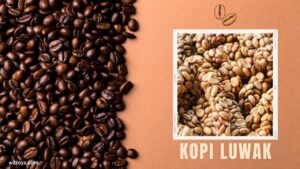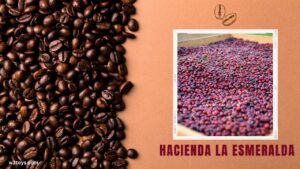Coffee is one of the most popular beverages worldwide, with millions of people drinking it every day. However, some coffee connoisseurs are willing to pay top dollar for a unique and rare cup of coffee. These expensive coffees are often produced in small quantities and have a distinct flavor profile that sets them apart from other types of coffee.
One of the most expensive types of coffee in the world is kopi luwak. This coffee is made from beans that have been partially digested and excreted by Asian palm civets. The beans are then collected, cleaned, and roasted to create a unique and highly sought-after coffee. Despite its high price tag, kopi luwak has faced criticism from some coffee professionals and critics due to ethical concerns surrounding the treatment of the civets.
Other expensive coffees include Jamaican Blue Mountain, which is known for its mild flavor and smooth finish, and Hacienda La Esmeralda, which is grown in Panama and has a floral and citrusy taste. These coffees are often produced in limited quantities and require a lengthy production process, which contributes to their high cost. While some may argue that the price tag is not justified, others believe that the unique flavor and rarity of these coffees make them worth the investment.
The Most Expensive Coffee in the World
Coffee is one of the most popular beverages consumed worldwide, with millions of people enjoying a cup of joe every day. However, some coffee lovers are willing to pay a premium for a rare and unique cup of coffee. In this section, we will explore the most expensive coffee in the world.
Kopi Luwak
Kopi Luwak is one of the most expensive coffees in the world, with a price ranging from $100 to $1,300 per kilogram. It is made from coffee beans that have been eaten and excreted by a civet cat, which is a small mammal native to Southeast Asia. The cat’s digestive system ferments the beans, giving them a unique flavor and aroma.
Despite its high price, Kopi Luwak has become increasingly popular among coffee enthusiasts, and its demand has led to the exploitation of civet cats. Many coffee producers keep the animals in captivity and feed them a diet of coffee beans, which is harmful to their health and well-being.
Black Ivory Coffee
Black Ivory Coffee is another expensive coffee, with a price of $1,081 per pound. It is made from Thai Arabica coffee beans that have been eaten and excreted by elephants. The elephants’ digestive system breaks down the beans, giving them a unique flavor and aroma.
Similar to Kopi Luwak, Black Ivory Coffee has faced criticism for its production process, which involves keeping elephants in captivity and feeding them a diet of coffee beans. Some animal welfare organizations have raised concerns about the welfare of the elephants and their living conditions.
Hacienda La Esmeralda
Hacienda La Esmeralda is a Panamanian coffee that has won numerous awards for its unique flavor and aroma. It is grown in the Boquete region of Panama, where the high altitude and volcanic soil provide ideal growing conditions for the coffee beans.
Hacienda La Esmeralda is known for its floral and fruity notes, with a hint of jasmine and bergamot. It is one of the most expensive coffees in the world, with a price of $350 per pound.
In conclusion, the most expensive coffees in the world are often made from beans that have been eaten and excreted by animals, giving them a unique flavor and aroma. However, the production process has faced criticism from animal welfare organizations, and coffee lovers should be aware of the ethical concerns surrounding these coffees.
Origins of Expensive Coffee
Coffee is one of the most popular beverages in the world, and there are many different types of coffee available. However, some types of coffee are more expensive than others, and these expensive coffees have interesting origins. In this section, we will explore the history of two of the most expensive coffees: Kopi Luwak and Black Ivory.
History of Kopi Luwak
Kopi Luwak is a type of coffee that is made from beans that have been eaten and excreted by civet cats. The civet cats eat the coffee cherries, and the beans pass through their digestive system. The beans are then collected from the cat’s feces, cleaned, roasted, and brewed into coffee.
Kopi Luwak originated in Indonesia, where it was discovered by Dutch colonists in the early 18th century. The Dutch colonists noticed that the local farmers were collecting the civet cat’s feces and using the beans to make coffee. The Dutch colonists tried the coffee and found that it had a unique flavor that was smoother and less bitter than other types of coffee.
Today, Kopi Luwak is one of the most expensive coffees in the world, with prices ranging from $100 to $1,300 per kilogram, depending on whether the beans are farmed or wild-collected.
Discovery of Black Ivory
Black Ivory is another type of expensive coffee that is made using elephants. The elephants eat the coffee cherries, and the beans pass through their digestive system. The beans are then collected from the elephant’s feces, cleaned, roasted, and brewed into coffee.
Black Ivory was discovered by Blake Dinkin, a Canadian entrepreneur, in 2012. Dinkin was inspired by the idea of using elephants to make coffee, and he spent several years developing the process. Today, Black Ivory is one of the most expensive coffees in the world, with prices ranging from $500 to $1,100 per kilogram.
While some people enjoy the unique flavor of Kopi Luwak and Black Ivory, others are concerned about the ethics of using animals to produce coffee. Animal welfare organizations have raised concerns about the treatment of civet cats and elephants used in the production of these coffees.
Production Process
Cultivation and Harvesting
The cultivation and harvesting process of the world’s most expensive coffees is a delicate and precise procedure. The coffee beans are grown in specific regions with unique soil and climate conditions that contribute to the coffee’s distinct flavor. The farmers carefully monitor the coffee plants’ growth and ensure they are adequately nourished and protected from pests and diseases.
Once the coffee cherries have ripened, the farmers selectively handpick them to ensure only the ripest and highest quality cherries are used in the production process. This process is time-consuming and labor-intensive, but it ensures the coffee’s quality is not compromised.
Animal Involvement
Some of the world’s most expensive coffees, such as Kopi Luwak, involve animal involvement in their production process. The coffee cherries are eaten by animals, such as civet cats, who digest the cherries, and the coffee beans are excreted in their feces. The beans are then collected, cleaned, and roasted to produce the coffee.
Although the animal involvement process may seem unorthodox, it is believed to contribute to the coffee’s unique flavor and aroma. However, it is important to note that the animal welfare concerns surrounding this practice have been raised, and consumers should be cautious when purchasing these types of coffees.
Roasting and Packaging
After the coffee beans have been harvested, they are roasted to perfection to bring out their unique flavors and aromas. The roasting process is carefully monitored to ensure the beans are not over or under-roasted, which could compromise the coffee’s quality.
Once the beans have been roasted, they are packaged and shipped to retailers worldwide. The packaging process is crucial as it ensures the coffee’s freshness is preserved, and the beans are not exposed to air or moisture, which could affect their quality.
In conclusion, the production process of the world’s most expensive coffees is a meticulous and precise procedure. From cultivation and harvesting to animal involvement and roasting and packaging, each step is critical in producing the highest quality coffee beans.
Factors Driving the Price
Scarcity
One of the main factors that drives up the price of coffee is scarcity. Some of the world’s most expensive coffees are grown in small quantities in remote regions, making them rare and difficult to obtain. For example, Kopi Luwak, also known as civet coffee, is produced in limited quantities because it is made from coffee beans that have been eaten and excreted by civets, a small mammal found in Southeast Asia. The labor-intensive process of collecting and cleaning the beans further adds to its scarcity and cost.
Labor Intensity
Another factor that contributes to the high price of coffee is labor intensity. Some of the world’s most expensive coffees are produced using labor-intensive methods, such as hand-picking only the ripest coffee cherries or drying the beans in the sun. For example, Jamaican Blue Mountain coffee is known for its high price due to the meticulous care taken during the harvesting and processing of the coffee beans. The beans are hand-picked and sun-dried, which requires a significant amount of manual labor.
Unique Flavor Profile
Lastly, the unique flavor profile of some coffees also drives up their price. Some of the world’s most expensive coffees are renowned for their distinct and complex flavor profiles, which are the result of specific growing conditions or processing methods. For example, Black Ivory coffee is produced in Thailand using a unique process where the coffee beans are fed to elephants, digested, and then collected from their dung. The resulting coffee has a unique flavor profile that is said to be smooth and chocolatey with hints of spice and earthiness.
Overall, the price of coffee is determined by a variety of factors, including scarcity, labor intensity, and unique flavor profiles. While some of the world’s most expensive coffees may seem extravagant, they are often the result of a combination of factors that make them rare and highly sought after by coffee connoisseurs.
Consumer Experience
Tasting Notes
When it comes to the world’s most expensive coffees, consumers expect a unique and exceptional taste experience. Many of these coffees are grown in specific regions, under specific conditions, and with unique processing methods. As a result, they often have distinct flavor profiles that set them apart from more common coffee varieties.
For example, Jamaican Blue Mountain coffee is known for its mild flavor, bright acidity, and hints of chocolate and nuts. On the other hand, Black Ivory coffee, which is made from beans that have been eaten and excreted by elephants, has a sweet, nutty taste with notes of chocolate and spice.
When trying these coffees, consumers should pay attention to their tasting notes and flavors. Some coffee connoisseurs recommend tasting the coffee black to fully appreciate its unique taste profile.
Buying Experience
Buying the world’s most expensive coffees can be a unique and exciting experience. Many of these coffees are only available in limited quantities, and some can only be purchased directly from the grower or through specialty retailers.
For example, Hacienda La Esmeralda, one of the most expensive coffees in the world, is only sold through a yearly auction. Buyers must register in advance and bid against other coffee enthusiasts to secure a bag of this rare and highly sought-after coffee.
Other coffees, like Jamaican Blue Mountain, can be found at specialty coffee shops or online retailers. However, consumers should be prepared to pay a premium price for these rare and exclusive varieties.
When buying these coffees, consumers should also consider the ethical and environmental impact of their purchase. Some of these coffees, like Kopi Luwak, have come under scrutiny for their controversial production methods. Buyers should research the sourcing and production of the coffee they are interested in to ensure they are making an informed and responsible purchase.
Controversies and Ethical Concerns
Animal Welfare Issues
The production of the most expensive coffee in the world, Kopi Luwak, has raised concerns about animal welfare. Civet cats, the animals responsible for partially digesting the coffee beans, are often kept in small, cramped cages and fed a diet solely consisting of coffee cherries. This practice has led to physical and psychological harm to the animals, as well as a decrease in their lifespan.
Many organizations, such as the World Society for the Protection of Animals, have spoken out against the inhumane treatment of civet cats in the production of Kopi Luwak. The lack of regulation and enforcement in the industry has made it difficult to ensure that the animals are being treated humanely.
Sustainability Concerns
The production of conventional coffee has significant sustainability concerns. Traditionally, coffee is grown in rainforests, which are some of the most delicate and diverse places on the planet. The deforestation and habitat destruction caused by conventional coffee production has led to the loss of biodiversity and increased carbon emissions.
Additionally, conventional coffee production often involves the use of harmful pesticides and fertilizers, which can contaminate soil and water sources. This has negative impacts on both the environment and the health of farmers and their communities.
Ethical Bean, a Canadian coffee company, has addressed these sustainability concerns by producing organic and fair trade coffee. They work directly with farmers to ensure that their coffee is grown in a way that is environmentally sustainable and socially responsible.
Conclusion
In conclusion, the world of coffee offers a vast range of flavors and aromas, and some of the most expensive coffees in the world come with unique production methods and exotic origins. While some of these coffees are considered a luxury item, others are produced in small quantities, making them rare and hard to find.
Kopi Luwak remains one of the most expensive coffees in the world, but ethical concerns have arisen about the treatment of civets in the production process. Jamaican Blue Mountain coffee is another expensive option, known for its mild flavor and smooth finish. However, due to its high demand and limited production, it can be challenging to find and afford.
Hawaiian Kona coffee is also a popular choice, with its unique growing conditions and rich flavor profile. However, it can be costly due to its limited production and high demand. Other expensive coffees, such as Black Ivory and Hacienda La Esmeralda, offer unique production methods and rare flavors, making them a popular choice among coffee enthusiasts.
Overall, the most expensive coffees in the world offer a unique and luxurious experience for those willing to pay the price. However, it’s important to keep in mind that price doesn’t always equate to quality, and there are plenty of excellent coffees available at a more affordable price point.
Frequently Asked Questions
What is the process of making Kopi Luwak coffee?
Kopi Luwak coffee is made from coffee beans that have been eaten and excreted by Asian palm civets. The beans are collected from the feces of these animals, cleaned, and roasted to produce coffee. The unique digestive process of the civets is said to give the coffee a distinct flavor.
How much does a pound of Kopi Luwak coffee cost?
Kopi Luwak coffee is one of the most expensive coffees in the world, with prices ranging from $30 to $100 per cup and up to $600 per pound. The high cost is due to the limited supply and the labor-intensive process of collecting and cleaning the beans.
What makes Kopi Luwak coffee so expensive?
The high cost of Kopi Luwak coffee is due to its rarity and the unique process of production. The coffee beans are only produced in small quantities and require a labor-intensive process to collect and clean them. Additionally, the popularity of the coffee has driven up demand, further increasing the price.
Are there any ethical concerns surrounding Kopi Luwak coffee production?
There are ethical concerns surrounding the production of Kopi Luwak coffee, as the process of collecting the beans can involve animal cruelty. Some producers keep the civets in small, cramped cages and force-feed them coffee cherries to increase production. Consumers should be aware of the source of their coffee and choose brands that use ethical and sustainable practices.
Are there any other types of expensive coffee besides Kopi Luwak?
Yes, there are several other types of expensive coffee, including Black Ivory coffee, Hacienda La Esmeralda, and St. Helena coffee. These coffees are also rare and require a labor-intensive process to produce, driving up their cost.
Is Kopi Luwak coffee worth the high price tag?
The value of Kopi Luwak coffee is subjective and depends on individual preferences. Some coffee connoisseurs believe that the unique flavor of the coffee justifies its high cost, while others argue that it is overpriced and not worth the expense. Ultimately, the decision to purchase Kopi Luwak coffee should be based on personal taste and ethical considerations.










